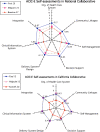Assessing Chronic Illness Care Education (ACIC-E): a tool for tracking educational re-design for improving chronic care education
- PMID: 20737235
- PMCID: PMC2940447
- DOI: 10.1007/s11606-010-1385-y
Assessing Chronic Illness Care Education (ACIC-E): a tool for tracking educational re-design for improving chronic care education
Abstract
Background: Recent Breakthrough Series Collaboratives have focused on improving chronic illness care, but few have included academic practices, and none have specifically targeted residency education in parallel with improving clinical care. Tools are available for assessing progress with clinical improvements, but no similar instruments have been developed for monitoring educational improvements for chronic care education.
Aim: To design a survey to assist teaching practices with identifying curricular gaps in chronic care education and monitor efforts to address those gaps.
Methods: During a national academic chronic care collaborative, we used an iterative method to develop and pilot test a survey instrument modeled after the Assessing Chronic Illness Care (ACIC). We implemented this instrument, the ACIC-Education, in a second collaborative and assessed the relationship of survey results with reported educational measures.
Participants: A combined 57 self-selected teams from 37 teaching hospitals enrolled in one of two collaboratives.
Analysis: We used descriptive statistics to report mean ACIC-E scores and educational measurement results, and Pearson's test for correlation between the final ACIC-E score and reported educational measures.
Results: A total of 29 teams from the national collaborative and 15 teams from the second collaborative in California completed the final ACIC-E. The instrument measured progress on all sub-scales of the Chronic Care Model. Fourteen California teams (70%) reported using two to six education measures (mean 4.3). The relationship between the final survey results and the number of educational measures reported was weak (R(2) = 0.06, p = 0.376), but improved when a single outlier was removed (R(2) = 0.37, p = 0.022).
Conclusions: The ACIC-E instrument proved feasible to complete. Participating teams, on average, recorded modest improvement in all areas measured by the instrument over the duration of the collaboratives. The relationship between the final ACIC-E score and the number of educational measures was weak. Further research on its utility and validity is required.
Figures



Similar articles
-
A multi-institutional quality improvement initiative to transform education for chronic illness care in resident continuity practices.J Gen Intern Med. 2010 Sep;25 Suppl 4(Suppl 4):S574-80. doi: 10.1007/s11606-010-1392-z. J Gen Intern Med. 2010. PMID: 20737232 Free PMC article.
-
Developing measures of educational change for academic health care teams implementing the chronic care model in teaching practices.J Gen Intern Med. 2010 Sep;25 Suppl 4(Suppl 4):S586-92. doi: 10.1007/s11606-010-1358-1. J Gen Intern Med. 2010. PMID: 20737234 Free PMC article.
-
Assessment of chronic illness care (ACIC): a practical tool to measure quality improvement.Health Serv Res. 2002 Jun;37(3):791-820. doi: 10.1111/1475-6773.00049. Health Serv Res. 2002. PMID: 12132606 Free PMC article.
-
Teaching in the outpatient clinic. Practical tips.J Gen Intern Med. 1997 Apr;12 Suppl 2(Suppl 2):S34-40. doi: 10.1046/j.1525-1497.12.s2.5.x. J Gen Intern Med. 1997. PMID: 9127242 Free PMC article. Review. No abstract available.
-
Applying Educational Theory to Interdisciplinary Education in Pediatric Cardiac Critical Care.World J Pediatr Congenit Heart Surg. 2019 Nov;10(6):742-749. doi: 10.1177/2150135119881370. Epub 2019 Oct 30. World J Pediatr Congenit Heart Surg. 2019. PMID: 31663840 Review.
Cited by
-
Health care costs attributable to overweight calculated in a standardized way for three European countries.Eur J Health Econ. 2016 Jan;17(1):61-9. doi: 10.1007/s10198-014-0655-8. Epub 2014 Nov 29. Eur J Health Econ. 2016. PMID: 25432787 Free PMC article.
-
Chronic-Care-Management Programs for Multimorbid Patients with Diabetes in Europe: A Scoping Review with the Aim to Identify the Best Practice.J Diabetes Res. 2021 Nov 9;2021:6657718. doi: 10.1155/2021/6657718. eCollection 2021. J Diabetes Res. 2021. PMID: 34796236 Free PMC article.
-
Evaluation of the primary care for chronic diseases in the high coverage context of the Family Health Strategy.BMC Health Serv Res. 2019 Nov 29;19(1):913. doi: 10.1186/s12913-019-4737-2. BMC Health Serv Res. 2019. PMID: 31783845 Free PMC article.
-
Future Rehabilitation Professionals' Intentions to Use Self-Management Support: Helping Students to Help Patients.Physiother Can. 2017;69(1):73-80. doi: 10.3138/ptc.2015-68E. Physiother Can. 2017. PMID: 28154447 Free PMC article.
-
A multi-institutional quality improvement initiative to transform education for chronic illness care in resident continuity practices.J Gen Intern Med. 2010 Sep;25 Suppl 4(Suppl 4):S574-80. doi: 10.1007/s11606-010-1392-z. J Gen Intern Med. 2010. PMID: 20737232 Free PMC article.
References
-
- Crossing the Quality Chasm: a New Health System for the Twenty-first Century. Washington: National Academy Press; 2001.
Publication types
MeSH terms
LinkOut - more resources
Full Text Sources

